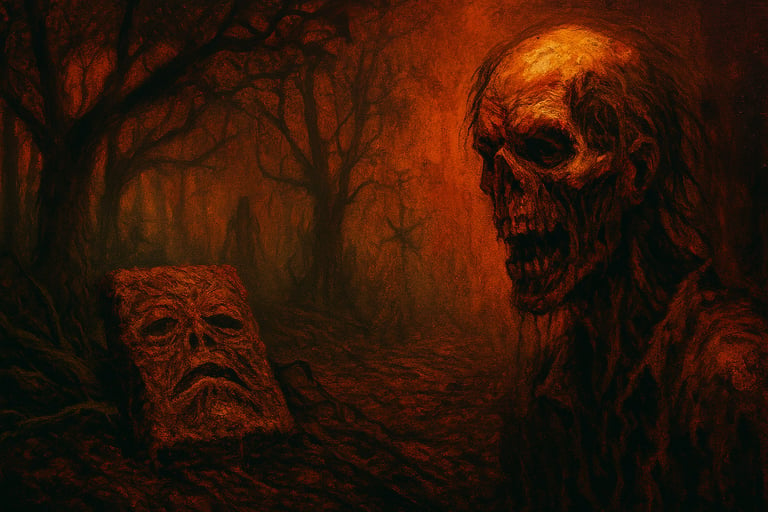Evil Dead Movies in Order: Full Guide
Explore the Evil Dead movies in order with reviews, analysis, and franchise insights. Discover how each film reshapes horror’s mythic ritual legacy forever.
HORROR REVIEWS
Marcel Helmar
10/30/20258 min read
Share:


CAPTION: The Book of the Dead and its cursed legacy — reshaping horror across every Evil Dead movie in order.
Opening the Book
The Evil Dead movies in order are not just a sequence of horror films; they are a ritual cycle, a cinematic Necronomicon opened again and again across four decades. Each entry is less a sequel than a retelling, a fever dream reshaped by its era, its director, and its audience.
This is the Evil Dead franchise explained not as a simple timeline, but as a myth that mutates with every telling. The Book of the Dead is the through‑line, but the real text is the franchise itself: a cursed scripture written in celluloid, blood, and laughter. To watch these films is to participate in the rite, to feel the myth reform itself in your subconscious.
What follows is not just a list, but Evil Dead movie reviews and analysis — five movements in the symphony of the Deadites.
Summon the Necronomicon
Own the legendary Book of the Dead. This hardcover Necronomicon replica brings the cursed lore of the Evil Dead franchise straight to your collection.
$15.99 - Amazon
I. The Evil Dead (1981) — The First Ritual
Sam Raimi’s debut is more than a horror film; it is a summoning. The Evil Dead feels like a midnight rite captured on celluloid, a mix of occult invocation and raw creative art. The camera itself becomes a demon, rushing through the woods with impossible velocity, as if the forest itself were possessed.
For all its low‑budget grit, the film radiates a strange perfection: the allure of horror distilled into its purest occult stylization. The Book of the Dead is the axis around which the nightmare turns, and its presence is ingenious. It doesn’t feel like a mere prop but a cursed artifact with weight, texture, and history.
Ash, in this first incarnation, is not yet the chainsaw messiah. He is a man in shock, stumbling through a nightmare he cannot process. His disbelief makes the possession sequences all the more brutal, because we see him resisting not only the Deadites, but the very idea that such evil could exist.
This is the first ritual of the franchise: a film that feels like it should not exist, and yet does — a cursed reel of celluloid that opened a door horror has never closed.
II. Evil Dead II: Dead by Dawn (1987) — The Acid Ritual
If The Evil Dead was the first summoning, Evil Dead II is the occultist’s second rite, a retelling that feels both like a remake and a sequel, as if the myth itself demanded to be told again, louder, stranger, more unhinged.
The film plays like the fever dream of a master occultist on psychedelics, an acid trip where demons are conjured not with solemn chants but with slapstick hysteria. Raimi’s camera doesn’t just move; it convulses, it laughs, it drags Ash through a carnival of psychosis.
Ash’s chainsaw hand is the perfect weapon for this demented ritual, not a tool of survival but a grotesque extension of his transformation. He is no longer the hapless victim of the first film; he is the occult horror hero incarnate, a man who has fused with his trauma to become something mythic.
And then there is the cabin itself, laughing. The mounted deer head, the furniture, the walls — all convulsing in mockery. It is one of the most iconic sequences in horror history because it doesn’t just show madness, it feels like madness.
Evil Dead II is not just a horror film; it is one of the most creative, surreal occult horror movies ever made.


Back From the Dead Skull T‑Shirt
Summoned from ritual fire and printed on black cotton, this psychedelic skull tee fuses horror and occult streetwear. A sigil of resurrection for the horror‑obsessed.
$22.50
III. Army of Darkness (1992/93) — The Fever Dream Apocalypse
If Evil Dead II was the acid ritual, then Army of Darkness is the fever dream that follows, a psychedelic twist from horror into pulp fantasy. Raimi doesn’t abandon the occult; he expands it, twisting the realms until Ash himself becomes both dreamer and dreamed, the mad occultist lost in his own ritual.
The skeleton army is more than campy homage to Ray Harryhausen. It is archetypal imagery, a memento mori phalanx marching straight out of the collective unconscious.
And Ash’s ego is the true star here. His one‑liners — “This is my boomstick!” — are not mere comic relief but ritual incantations, words of power that cement his role as the self‑anointed hero of his own fever trip.
The endings reflect this duality. The theatrical S‑Mart showdown is the logical conclusion to a self‑indulgent fever dream: Ash back in the mundane world, still mythologizing himself, still fighting Deadites in the aisles of consumerism. But the alternate post‑apocalypse ending reveals the cost of hubris, the nightmare that awaits when the dreamer oversleeps.
Army of Darkness is not a departure from horror but its apotheosis, the moment the occult ritual bursts its cabin walls and spills into pulp myth, comedy, and apocalypse.
IV. Evil Dead (2013) — The Blood‑Rain Retelling
If Raimi’s trilogy was a fever dream, Fede Álvarez’s Evil Dead is the nightmare that follows detox. The film reframes the cabin ritual through Mia’s withdrawal, making the story both an allegory of addiction and a ritual initiation.
The tone shift is deliberate. Gone is Raimi’s surreal comedy; in its place is a relentless attempt to craft the “scariest horror movie of all time.” The result is brutal, visceral, and entertaining, but in its pursuit of terror, it blunts some of the strange creativity that made the original so enduring.
Still, the film has its moments of clever invention. The nail gun sequence is the standout, a modernized ritual of pain that feels both shocking and ingenious. And the blood‑rain finale, while operatic, plays more like a spectacle than a revelation.
Mia is not a mirror of Ash, nor could she be. Ash is an archetype too singular, too iconic to be replicated. Instead, Mia becomes a different archetype for a different age, a survivor forged in trauma rather than comedy. Like Evil Dead II retelling the first film in a new key, the 2013 remake is less a replacement than a parallel ritual, a new mask worn by the same demon.
V. Evil Dead Rise (2023) — The Urban Nightmare Vignette
Where the 2013 remake tried to be the “scariest horror movie ever made,” Evil Dead Rise feels more like a nightmare vignette: contained, claustrophobic, and yet undeniably entertaining. By shifting the setting from the cabin to a crumbling Los Angeles apartment tower, the film expands the myth outward, but not into something grander.
The imagery of the mother‑as‑Deadite is the film’s most potent curse. It is maternal horror at its rawest, possession not just of a body but of the family unit itself. The cheese grater sequence is the standout, a moment of grotesque ingenuity that instantly carved itself into the franchise’s hall of infamous set‑pieces.
As a whole, Evil Dead Rise doesn’t expand the mythology into some vast new cosmology. Instead, it offers a self‑contained nightmare, a vignette that reformulates the myth for a new generation. It is well‑produced, entertaining, and fun, a reminder that the Evil Dead movies in order are endlessly malleable, capable of reforming themselves into new shapes without losing their cursed allure.
Closing the Circle
Across five films, the Evil Dead saga has proven itself less a linear story than a ritual cycle. Each entry is a retelling, a new mask worn by the same demon, a page torn from the same cursed book.
Ash begins as a victim, becomes a delirious hero, and finally ascends into pulp legend. Mia emerges as a survivor forged in trauma, a modern archetype who carries the curse into a new age. Evil Dead Rise shows that the Book of the Dead can surface anywhere, in any form, and still unleash the same nightmare.
What binds them all is the sense of ritual. These films are not just horror stories but initiations. They drag us into madness, force us to laugh at terror, and remind us that survival is never clean. The Necronomicon is more than a prop; it is the franchise itself, a text that cannot be closed, only re‑opened.
The circle is never truly sealed. Another filmmaker will find the book, another cast will bleed for it, and another audience will scream and laugh in equal measure. That is the curse and the gift of The Evil Dead: a horror myth that refuses to die, forever rising, forever retold.
Share:
FAQ: Evil Dead Movies in Order
1. What is the correct order to watch the Evil Dead movies?
The Evil Dead movies in order are:
The Evil Dead (1981)
Evil Dead II: Dead by Dawn (1987)
Army of Darkness (1992/93)
Evil Dead (2013)
Evil Dead Rise (2023)
This is the release order, which is also the best way to experience the franchise’s evolving myth.
2. Do I need to watch the Evil Dead movies in order?
Not strictly. Each film is a retelling of the same cursed ritual, reshaped for its time. Watching in order gives you the full arc of Ash’s transformation and the franchise’s tonal shifts, but each entry can stand alone as its own nightmare.
3. Is Evil Dead II a sequel or a remake?
Both. Evil Dead II begins by retelling the first film in condensed form, then spirals into new territory. It’s less a sequel than a ritual repetition — the myth demanded to be told again, louder and stranger.
4. How does the 2013 Evil Dead connect to the originals?
The 2013 film is not a direct continuation but a parallel retelling. It reframes the cabin ritual through Mia’s detox, creating a new archetype for a new age. Think of it as another page in the Necronomicon rather than a remake.
5. What makes Evil Dead Rise different?
Evil Dead Rise shifts the setting from the cabin to an urban apartment tower, turning the ritual into a claustrophobic nightmare vignette. It doesn’t expand the myth into a grand cosmology, but it proves the curse can surface anywhere.
6. Will there be more Evil Dead movies?
The circle is never truly sealed. The Necronomicon always finds a new reader. Raimi and Campbell have hinted at future projects, and the success of Evil Dead Rise suggests the franchise will continue to reform itself in new shapes.
Keep the Flame Lit
The ritual doesn’t end when the candle gutters out. Protection, inspiration, and new workings continue in the quiet ember glow. Subscribe and I’ll send you fresh rites, occult insights, and updates from Horror & Hexes — sparks to keep your own fire alive.
About the Author:
Marcel Helmar is a cinematic occult artist, writer, and founder of Horror & Hexes. His work blends ritual symbolism, folk horror, and studio‑grade printmaking to produce limited art drops, immersive essays, and practical ritual guides.
Marcel’s writing and visual practice have been used by filmmakers, podcasters, and indie publishers to create atmosphere and authenticity; he teaches workshops on image making, lore research, and publishing for dark‑culture creators. Visitors can browse his gallery, read deep‑dive essays, or join the mailing list for exclusive drops and process notes.
Connect
Explore dark tales and ritualistic mysteries here.
Support
+1-337-718-0155
© 2025. All rights reserved.
Flesh Catechism T-Shirt
Eat Your Heart Out
$22.50

